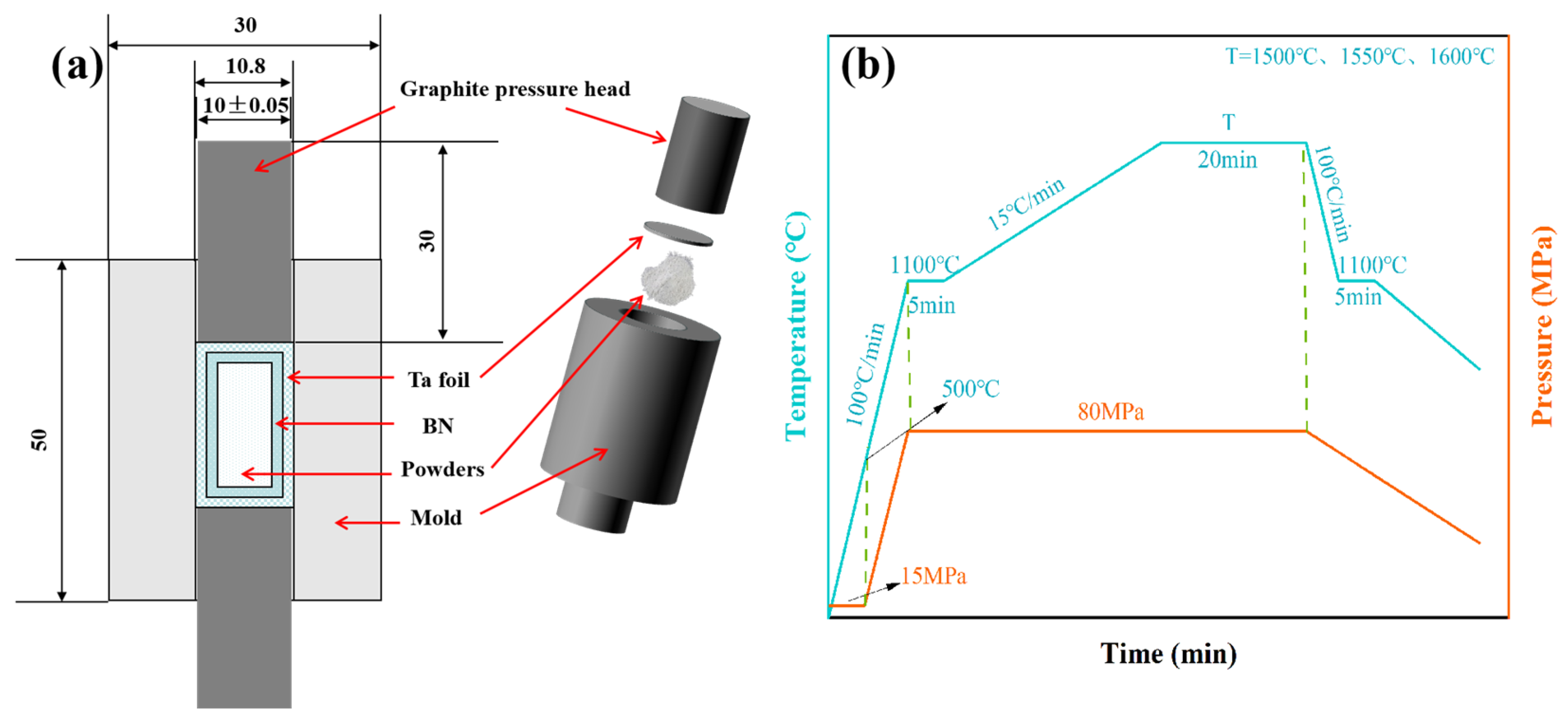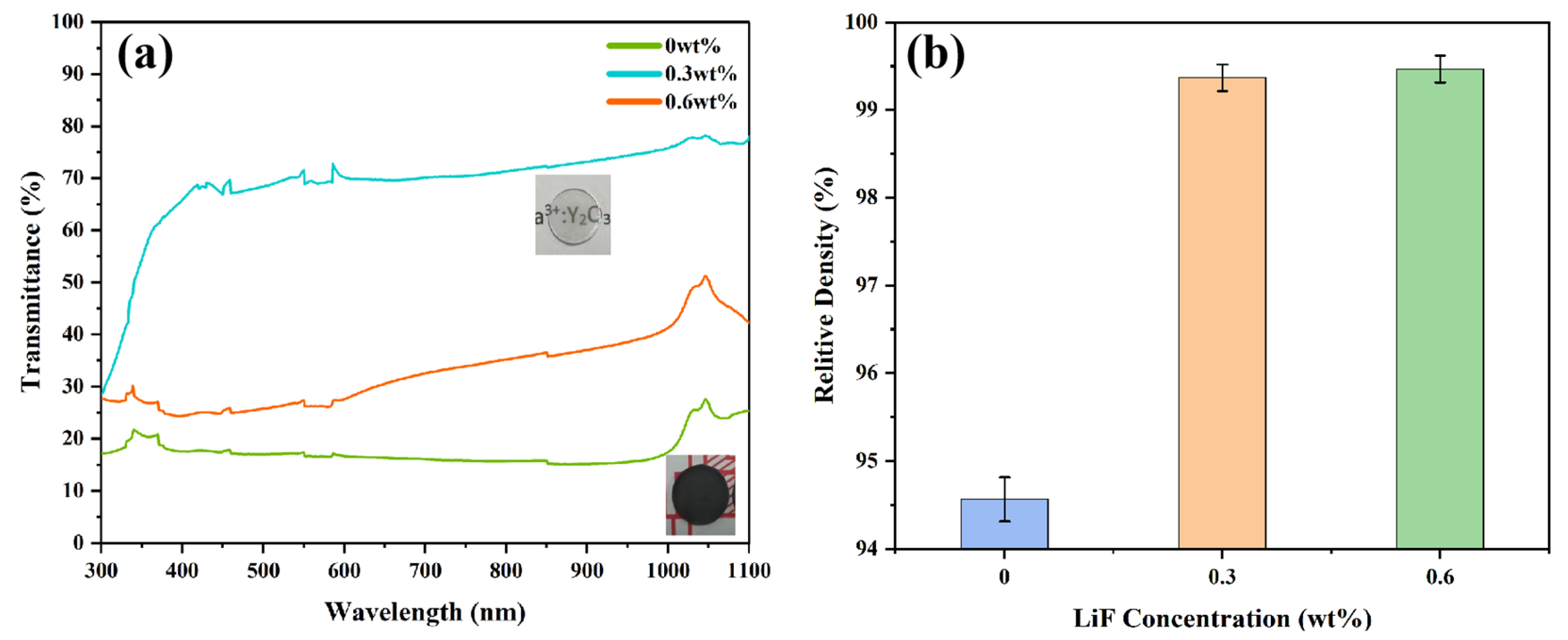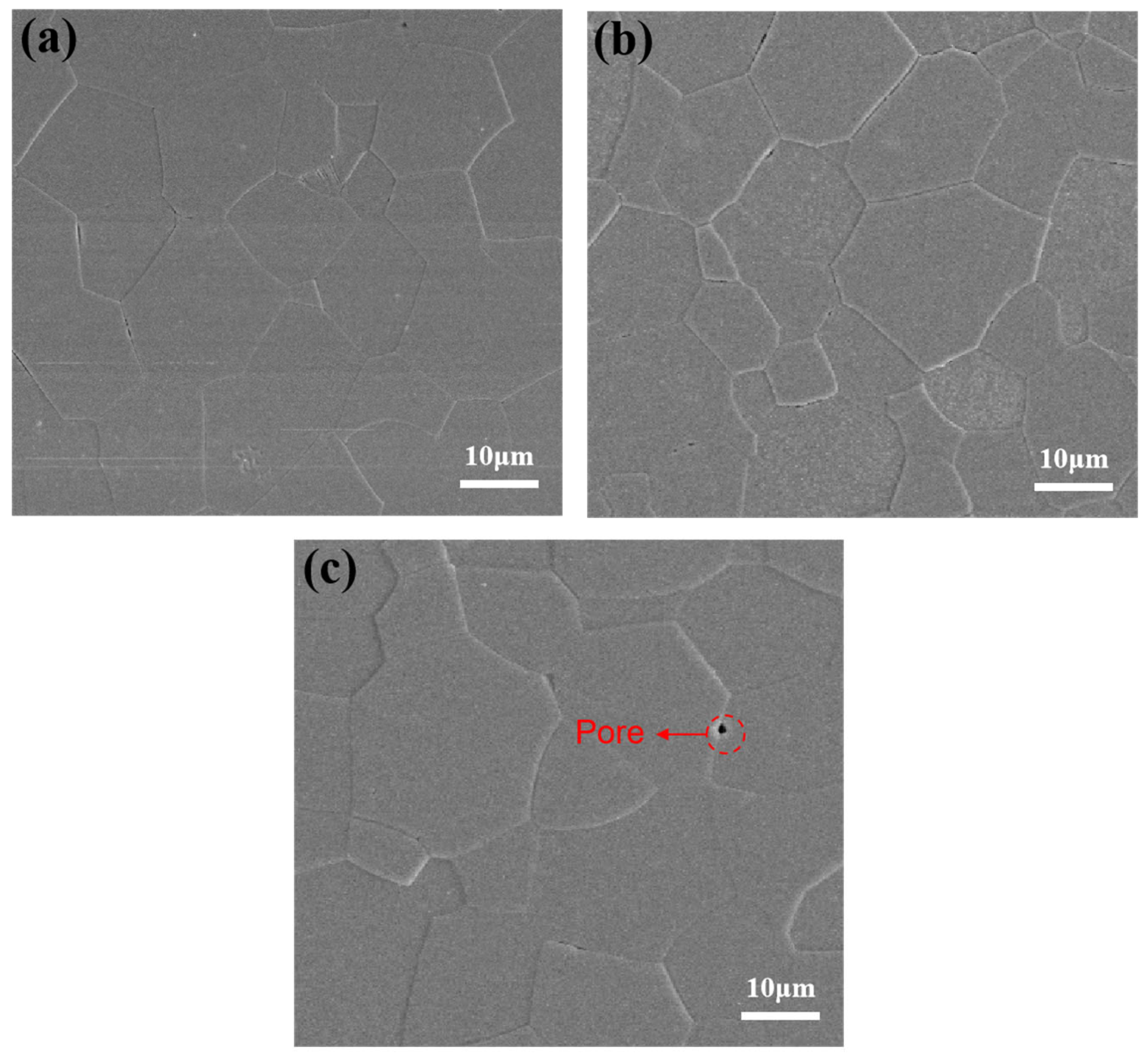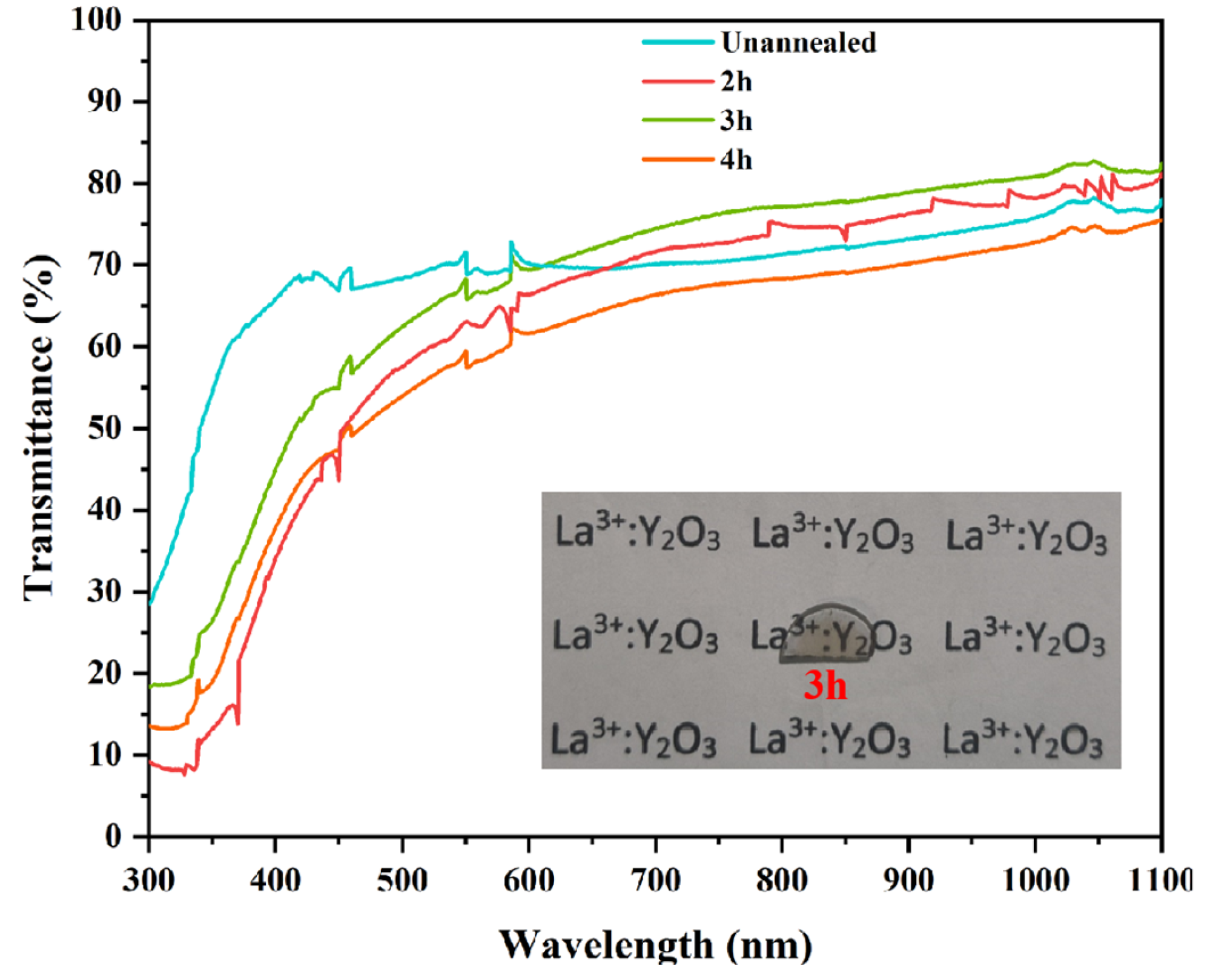Microstructure and Optical Properties of Y1.8La0.2O3 Transparent Ceramics Prepared by Spark Plasma Sintering
Abstract
1. Introduction
2. Experimental
2.1. Sample Preparation
2.2. Characterization
3. Results and Discussion
4. Conclusions
Author Contributions
Funding
Institutional Review Board Statement
Informed Consent Statement
Data Availability Statement
Conflicts of Interest
References
- Aleksandrovich, A. Laser Crystals: Their Physics and Properties; Springer: Berlin/Heidelberg, Germany, 1990. [Google Scholar]
- Klein, P.H.; Croft, W.J. Thermal conductivity, diffusivity, and expansion of Y2O3, Y3Al5O12, and LaF3 in the range 77–300 K. J. Appl. Phys. 1967, 38, 1603–1607. [Google Scholar] [CrossRef]
- Fukabori, A.; Yanagida, T.; Pejchal, J.; Maeo, S.; Yokota, Y.; Yoshikawa, A.; Ikegami, T.; Moretti, F.; Kamada, K. Optical and scintillation characteristics of Y2O3 transparent ceramic. J. Appl. Phys. 2010, 107, 073501. [Google Scholar] [CrossRef]
- Zhang, L.; Yang, J.; Yu, H.; Pan, W. Highly efficient up-conversion in Nd: Y2O3 transparent ceramics. Scr. Mater. 2020, 178, 281–284. [Google Scholar] [CrossRef]
- Zhang, L.; Yang, J.; Yu, H.; Pan, W. High performance of La-doped Y2O3 transparent ceramics. J. Adv. Ceram. 2020, 9, 493–502. [Google Scholar] [CrossRef]
- Osipov, V.V.; Shitov, V.A.; Maksimov, R.N.; Lukyashin, K.E.; Solomonov, V.I.; Ishchenko, A.V. Fabrication and characterization of IR-transparent Fe2+ doped MgAl2O4 ceramics. J. Am. Ceram. Soc. 2019, 102, 4757–4764. [Google Scholar] [CrossRef]
- Zhang, Y.M.; Wu, H.Y.; Jia, B.R.; Qu, X.H.; Qing, M.L. Preparation method and research progress of AlON transparent ceramics. Powder Metall. Technol. 2024, 42, 97–106. [Google Scholar]
- Krell, A.; Blank, P.; Ma, H.; Hutzler, T.; Van Bruggen, M.P.B.; Apetz, R. Transparent sintered corundum with high hardness and strength. J. Am. Ceram. Soc. 2003, 86, 12–18. [Google Scholar] [CrossRef]
- Apetz, R.; Van Bruggen, M.P.B. Transparent alumina: A light-scattering model. J. Am. Ceram. Soc. 2003, 86, 480–486. [Google Scholar] [CrossRef]
- Yamashita, I.; Tsukuma, K. Light scattering by residual pores in transparent zirconia ceramics. J. Ceram. Soc. Jpn. 2011, 119, 133–135. [Google Scholar] [CrossRef]
- Tsukuma, K.; Yamashita, I.; Kusunose, T. Transparent 8 mol% Y2O3–ZrO2 (8Y) ceramics. J. Am. Ceram. Soc. 2008, 91, 813–818. [Google Scholar] [CrossRef]
- Rhodes, W.H. Controlled transient solid second-phase sintering of yttria. J. Am. Ceram. Soc. 1981, 64, 13–19. [Google Scholar] [CrossRef]
- Prokop, K.A.; Cottrino, S.; Garnier, V.; Fantozzi, G.; Guyot, Y.; Boulon, G.; Guzik, M. Enhancing transparency in non-cubic calcium phosphate ceramics: Effect of starting powder, LiF doping, and spark plasma sintering parameters. Ceramics 2024, 7, 607–624. [Google Scholar] [CrossRef]
- Hou, X.; Zhou, S.; Li, Y.; Li, W. Effect of ZrO2 on the sinterability and spectral properties of (Yb0.05Y0.95)2O3 transparent ceramic. Opt. Mater. 2010, 32, 920–923. [Google Scholar] [CrossRef]
- Kosyanov, D.Y.; Yavetskiy, R.P.; Kryzhanovska, O.S.; Vornovskikh, A.A.; Shichalin, O.O.; Papynov, E.K.; Gerasimenko, A.V.; Leonov, A.A.; Zavjalov, A.P. Reactive SPS of Nd3+: YAG transparent ceramics with LiF sintering additive. Opt. Mater. 2021, 119, 111389. [Google Scholar] [CrossRef]
- Omori, M. Sintering, consolidation, reaction and crystal growth by the spark plasma system. Mater. Sci. Eng. A 2008, 287, 183–188. [Google Scholar] [CrossRef]
- Chaim, R.; Marder, R.; Estournes, C. Optically transparent ceramic by spark plasma sintering of oxide nanoparticals. Scr. Mater. 2010, 63, 211–214. [Google Scholar] [CrossRef]
- Zhang, L.; Feng, J.; Pan, W. Vacuum sintering of transparent Cr: Y2O3 ceramics. Ceram. Int. 2015, 41, 8755–8760. [Google Scholar] [CrossRef]
- Permin, D.A.; Egorov, S.V.; Belyaev, A.V.; Balabanov, S.S.; Koshkin, V.A.; Boldin, M.S.; Novikova, A.V.; Timofeev, O.V.; Ladenkov, I.V. Microwave sintering of IR-transparent Y2O3–MgO composite ceramics. Ceram. Int. 2023, 49, 7236–7244. [Google Scholar] [CrossRef]
- Liu, Y.; Liu, C.; Qin, X.; Gan, L.; Zhou, G.; Jiang, J.; Zhang, T.; Chen, H.; Wang, W.; Wang, S. Fabrication and luminescent properties of highly transparent Er: Y2O3 ceramics by hot pressing sintering. Materials 2023, 16, 4504. [Google Scholar] [CrossRef]
- Chaim, R.; Shlayer, A.; Estournes, C. Densification of nanocrystalline Y2O3 ceramic powder by spark plasma sintering. J. Eur. Ceram. Soc. 2009, 29, 91–98. [Google Scholar] [CrossRef]
- Liu, L.; Morita, K.; Suzuki, T.S.; Kim, B.N. Effect of the heating rate on the spark-plasma-sintering (SPS) of transparent Y2O3 ceramics: Microstructural evolution, mechanical and optical properties. Ceramics 2021, 4, 56–69. [Google Scholar] [CrossRef]
- Gild, J.; Floyd, A.; Sadowski, B.; Zhou, T.; Kim, W.; Bayya, S.; Sanghera, J. Temperature dependence of carbon contamination in spark plasma sintered Y2O3. J. Eur. Ceram. Soc. 2024, 44, 4255–4259. [Google Scholar] [CrossRef]
- Sakajio, M.; Shter, G.E.; Mann-Lahav, M.; Beilin, V.; Zamir, S.; Grader, G.S. Carbon contamination prevention during spark plasma sintering. ACS Appl. Mater. Interfaces 2023, 15, 38080–38089. [Google Scholar] [CrossRef]
- Pan, Y.; Lin, H.; Liu, J.; Xu, X.; Hong, R.; Tao, C.; Han, Z.; Zhang, D. Fabrication and spectral properties of Yb, Ho:Y2O3 transparent ceramics. Opt. Mater. 2021, 112, 110479. [Google Scholar] [CrossRef]
- Chen, W.; Tu, H.; Sahi, S.; Mao, D.; Kenarangui, R.; Luo, J.; Jin, P.; Liu, S.; Ma, L.; Brandt, A.; et al. Luminescence of La0.2Y1.8O3 nanostructured scintillators. Opt. Lett. 2014, 39, 5705–5708. [Google Scholar] [CrossRef]
- Lu, S.; Yang, Q.; Zhang, B.; Zhang, H. Upconversion and infrared luminescences in Er3+/Yb3+ codoped Y2O3 and (Y0.9La0.1) 2O3 transparent ceramics. Opt. Mater. 2011, 33, 746–749. [Google Scholar] [CrossRef]
- Li, X.; Mao, X.; Feng, M.; Qi, S.; Jiang, B.; Zhang, L. Fabrication of transparent La-doped Y2O3 ceramics using different La2O3 precursors. J. Eur. Ceram. Soc. 2016, 36, 2549–2553. [Google Scholar] [CrossRef]
- Yin, R.; Li, J.; Dong, M.; Xie, T.; Fu, Y.; Luo, W.; Ge, L.; Kou, H.; Pan, Y.; Guo, J. Fabrication of Nd: YAG transparent ceramics by non-aqueous gelcasting and vacuum sintering. J. Eur. Ceram. Soc. 2016, 36, 2543–2548. [Google Scholar] [CrossRef]
- Yang, Q.H.; Zhou, H.X.; Xu, J.; Su, L.B. Synthesis and luminescence characterization of cerium doped Lu2O3-Y2O3-La2O3 solid solution transparent ceramics. Opt. Express 2008, 16, 12290–12295. [Google Scholar] [CrossRef]
- Liu, C.; Zhou, G.; Jiang, J.; Hu, S.; Zhang, T.; Wang, S.; Xue, Z.; Lin, H.; Qin, X.; Gan, L. Fabrication and luminescence properties of highly transparent and submicrometer-grained Yb:Y2O3 ceramics by hot-pressing sintering. J. Alloys Compd. 2022, 898, 163002. [Google Scholar] [CrossRef]
- Luo, J.M.; Tu, H.Q.; Xu, J.L.; Deng, L.P. Preparation of Y1.8La0.2O3 transparent ceramics by microwave sintering. J. Heat Treat. Mater. 2014, 35, 15–19. [Google Scholar]
- Meir, S.; Kalabukhov, S.; Froumin, N.; Dariel, M.P.; Frage, N. Synthesis and densification of transparent magnesium aluminate spinel by SPS processing. J. Am. Ceram. Soc. 2009, 92, 358–364. [Google Scholar] [CrossRef]
- Sakajio, M.; Beilin, V.; Mann-Lahav, M.; Zamir, S.; Shter, G.E.; Grader, G.S. Highly transparent polycrystalline MgO via spark plasma sintering. ACS Appl. Mater. Interfaces 2022, 14, 52108–52116. [Google Scholar] [CrossRef] [PubMed]
- Frage, N.; Kalabukhov, S.; Sverdlov, N.; Ezersky, V.; Dariel, M.P. Densification of transparent yttrium aluminum garnet (YAG) by SPS processing. J. Eur. Ceram. Soc. 2010, 30, 3331–3337. [Google Scholar] [CrossRef]
- Katz, A.; Barraud, E.; Lemonnier, S.; Sorrel, E.; Eichhorn, M.; Astorg, S.; Leriche, A. Role of LiF additive on spark plasma sintered transparent YAG ceramics. Ceram. Int. 2017, 43, 15626–15634. [Google Scholar] [CrossRef]
- Ratzker, B.; Wagner, A.; Kalabukhov, S.; Froumin, N.; Frage, N. The role of high pressure in preventing carbon contamination of transparent ceramics during spark plasma sintering. Scr. Mater. 2023, 226, 115252. [Google Scholar] [CrossRef]
- Dorodnyy, A.; Smajic, J.; Leuthold, J. Mie scattering for photonic devices. Laser Photonics Rev. 2023, 17, 2300055. [Google Scholar] [CrossRef]
- Marder, R.; Chaim, R.; Chevallier, G.; Estournès, C. Effect of 1 wt.% LiF additive on the densification of nanocrystalline Y2O3 ceramics by spark plasma sintering. J. Eur. Ceram. Soc. 2011, 31, 1057–1066. [Google Scholar] [CrossRef]
- Gilde, G.; Patel, P.; Patterson, P.; Blodgett, D.; Duncan, D.; Hahn, D. Evaluation of hot pressing and hot isostastic pressing parameters on the optical properties of spinel. J. Am. Ceram. Soc. 2005, 88, 2747–2751. [Google Scholar] [CrossRef]
- Ahmadi, B.; Reza, S.R.; Ahsanzadeh-Vadeqani, M.; Barekat, M. Mechanical and optical properties of spark plasma sintered transparent Y2O3 ceramics. Ceram. Int. 2016, 42, 17081–17088. [Google Scholar] [CrossRef]
- Wang, S.F.; Zhang, J.; Luo, D.W.; Gu, F.; Tang, D.Y.; Dong, Z.L.; Tan, G.E.B.; Que, W.X.; Zhang, T.S.; Li, S.; et al. Transparent ceramics: Processing, materials and applications. Prog. Solid State Chem. 2013, 41, 20–54. [Google Scholar] [CrossRef]
- Amirzadeh-Fotovat, V.; Hatefi, Y. The effect of SPS parameters on the production of yttria transparent ceramic. Int. J. Appl. Ceram. Technol. 2019, 16, 1441–1449. [Google Scholar] [CrossRef]
- Shi, Z.; Jiang, Z.; Zhou, H.; Tang, R. Study on the effects of oxygen vacancy in SrCoOx thin films. Appl. Phys. 2016, 6, 205. [Google Scholar] [CrossRef]
- Li, Q.; Wang, Y.; Wang, J.; Ma, J.; Ni, M.; Lin, H.; Zhang, J.; Liu, P.; Xu, X.; Tang, D. High transparency Pr: Y2O3 ceramics: A promising gain medium for red emission solid-state lasers. J. Adv. Ceram. 2022, 11, 874–881. [Google Scholar] [CrossRef]










| Elements | Point 1 (at%) | Point 2 (at%) | Point 3 (at%) | Point 4 (at%) |
|---|---|---|---|---|
| Y | 34.24 | 36.37 | 35.09 | 34.38 |
| La | 3.30 | 3.60 | 3.31 | 3.72 |
| F | 3.62 | 0 | 0.27 | 0.23 |
| O | 58.83 | 60.03 | 61.33 | 61.67 |
Disclaimer/Publisher’s Note: The statements, opinions and data contained in all publications are solely those of the individual author(s) and contributor(s) and not of MDPI and/or the editor(s). MDPI and/or the editor(s) disclaim responsibility for any injury to people or property resulting from any ideas, methods, instructions or products referred to in the content. |
© 2025 by the authors. Licensee MDPI, Basel, Switzerland. This article is an open access article distributed under the terms and conditions of the Creative Commons Attribution (CC BY) license (https://creativecommons.org/licenses/by/4.0/).
Share and Cite
Luo, J.; Huang, X.; Deng, L. Microstructure and Optical Properties of Y1.8La0.2O3 Transparent Ceramics Prepared by Spark Plasma Sintering. Materials 2025, 18, 1389. https://doi.org/10.3390/ma18071389
Luo J, Huang X, Deng L. Microstructure and Optical Properties of Y1.8La0.2O3 Transparent Ceramics Prepared by Spark Plasma Sintering. Materials. 2025; 18(7):1389. https://doi.org/10.3390/ma18071389
Chicago/Turabian StyleLuo, Junming, Xu Huang, and Liping Deng. 2025. "Microstructure and Optical Properties of Y1.8La0.2O3 Transparent Ceramics Prepared by Spark Plasma Sintering" Materials 18, no. 7: 1389. https://doi.org/10.3390/ma18071389
APA StyleLuo, J., Huang, X., & Deng, L. (2025). Microstructure and Optical Properties of Y1.8La0.2O3 Transparent Ceramics Prepared by Spark Plasma Sintering. Materials, 18(7), 1389. https://doi.org/10.3390/ma18071389





